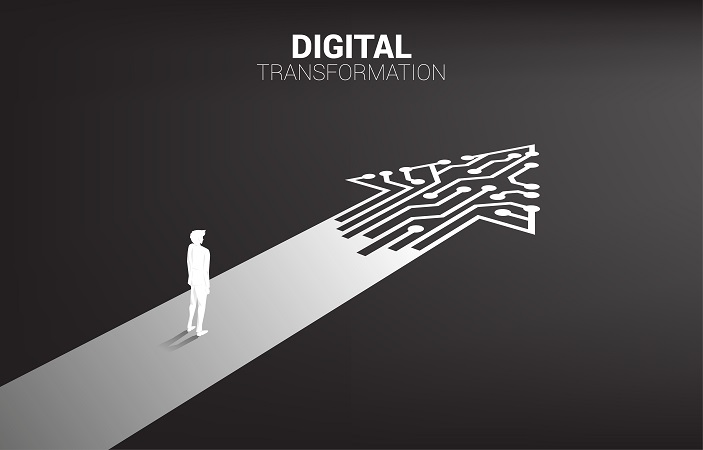Digital Transformation is essential for businesses to succeed in today’s digital world, but many CIOs struggle to achieve their Digital Transformation goals.
To improve their chances of success, organizations can take several steps, including conducting a thorough assessment, developing a clear roadmap, leveraging external expertise, fostering a culture of innovation, focusing on customer experience, establishing a governance model and incessantly monitoring and fine-tuning.
The first step to achieving Digital Transformation is conducting a comprehensive assessment. This involves evaluating the organization’s digital maturity and recognizing the barriers to Digital Transformation. It’s crucial to understand where an organization is, where it wants to be and how to get there.
Once organizations have identified their goals, CIOs need to develop a clear roadmap that outlines the steps needed to accomplish Digital Transformation. This roadmap should be aligned with the organization’s strategic objectives and should identify clear milestones for success.
Organizations can profit from external expertise, such as consultants or technology partners, to help steer them through the Digital Transformation process. These experts can bring experience and knowledge from other successful transformations and help identify answers to particular challenges.
To cultivate a culture of innovation, organizations should stimulate improvement by providing the necessary resources, tools and training for employees to develop new skills and ideas. This requires a shift in mindset, where employees are urged to experiment and try new things.
Successful Digital Transformation is centered around customer experience. Organizations need to focus on understanding their customers’ needs and preferences and develop solutions that deliver value to them.
To ensure accountability and achievement, organizations need to establish a governance model that outlines roles and responsibilities, decision-making processes and metrics for success. This model should also create clear communication channels between stakeholders and ensure that everyone is aligned with the organization’s objectives.
Digital Transformation is an ongoing process and organizations need to continuously monitor their progress and adjust their roadmap as needed. Regular reviews and evaluations can help identify areas for improvement and ensure that the organization remains on track to achieve its objectives.
Michael Bernstein, CTO, Clicksign

A digital maturity assessment can help organizations understand where they are in their Digital Transformation journey and identify gaps in their technological capabilities. With this information, organizations can set clear goals and a roadmap to achieve them.
Corporations can benefit from partnerships with technology-focused companies, such as consulting firms and system integrators, to help them develop and implement Digital Transformation solutions. These partnerships can bring expertise, skills, and resources to accelerate the institution’s Digital Transformation journey.
Investing in training and upskilling employees, for example, can help develop the skills and knowledge necessary to successfully implement innovative solutions. This may include training in emerging technologies, as well as skills such as data analysis and change management.
Furthermore, organizations should maintain a customer-centric focus in their Digital Transformation journey, seeking to understand consumers’ needs and expectations and developing digital solutions that meet those needs. This may involve creating new digital business models and adopting a much more modern culture.
Electronic signature can be a valuable tool for organizations struggling with their Digital Transformation journeys as it can help streamline processes involving documents and contracts by eliminating the need to print, sign, and scan paper documents. This can reduce the time required to complete processes and improve operational efficiency. It also enhances the customer experience by allowing them to sign documents and contracts remotely and conveniently, without the need to visit an office or send physical documents. This can improve brand loyalty.
In summary, organizations struggling with their Digital Transformation journeys can be aided through digital maturity assessments, strategic partnerships, training and upskilling, adoption of emerging technologies, and a customer-focused approach. By adopting a strategic and collaborative approach, organizations can overcome the challenges of Digital Transformation and achieve long-term success.
Roberto Hashioka, CTO, Nextron Energia

Organizations that seek to adapt and thrive in the era of Digital Transformation must establish clear and realistic goals aligned with their business objectives. This strategic approach is essential to ensure the success of Digital Transformation initiatives and ensure that resources are applied efficiently and effectively.
Obtaining engagement and support from executive leadership is a key element in this process. Top management must be committed to Digital Transformation and understand its impact on the business in order to make informed decisions and support the necessary changes. Executive leadership must lead by example, promoting a culture of innovation and agility throughout the organization.
To cultivate this culture of innovation, it is necessary to invest in the training and development of the people involved in the Digital Transformation process. This includes continuous training and education, as well as the acquisition and retention of talent with updated skills and knowledge in key areas of technology and innovation.
By empowering employees and providing them with the necessary tools and resources, organizations can ensure that their teams are ready to face the challenges and opportunities of Digital Transformation.
Cultural and structural changes within companies are fundamental to the success of Digital Transformation. This involves reviewing processes, organizational structures, and management systems to ensure they are agile and flexible, allowing companies to respond quickly to changes in the business environment and take advantage of emerging opportunities. Digital Transformation also requires a collaborative mindset and a willingness to experiment and learn from mistakes in order to drive innovation and growth.
Organizations seeking to benefit from Digital Transformation must establish clear and realistic goals aligned with business objectives and ensure engagement and support from executive leadership. Promoting a culture of innovation and agility is crucial, as is investing in the empowerment of the people involved and driving cultural and structural changes within the company. By adopting these strategies, organizations will be well positioned to address the challenges of Digital Transformation and seize the opportunities it offers to improve efficiency, innovation and sustainable growth.
Ricardo Scheffer, CEO, SONDA Brazil

It is not news that the COVID-19 pandemic has permanently transformed the relationship between companies and people. In this scenario, the consolidation of Digital Transformation, which was previously seen as a future project, was immediately required for organizations to communicate, produce and market their products and services in a digital format.
The pandemic introduced a technological complexity that did not exist in previous times. The advancements and changes in terms of digitization, modernization and innovation must continue.
Therefore, it becomes essential for corporations to modernize their internal and external infrastructures and systems to improve access, experience, communication, and the provision of products and services. Certainly, it will be a complex task as we are dealing with a framework that requires the integration of numerous systems into physical or virtualized infrastructures, in proprietary, third-party, or shared environments, as well as the use of multiple platforms.
To undergo this transition and address these demands, organizations can rely on service providers, integrators and consultancies. At this point, the initiative to support and impact companies in their modernization efforts must go beyond a business perspective. In other words, through their technological capabilities, these partners must understand the needs of each sector, stay connected to trends and focus on the transformation of companies and individuals, thus seeking a more developed and engaged society.
A comprehensive set of skills is more than necessary because the technological infrastructure has become just a means to achieve objectives. More than a business strategy, we are talking about a change in the quality of life for people. It is also necessary to take into consideration the reality and culture of each organization, including financial situation, geographic location and structural issues – among other aspects.
Market advancements towards digital modernization are evident across all segments, from small businesses to large corporations. We experience the reflection of this evolution in our daily lives, consuming goods and services produced and made available through channels impacted by the technological changes brought by the pandemic. We have progressed, and the trend is to continue evolving on this path of digital heritage to meet the needs of today’s citizens, whether as end consumers, employees, or in any other role. It is time to reinvent society.
Click below to share this article

